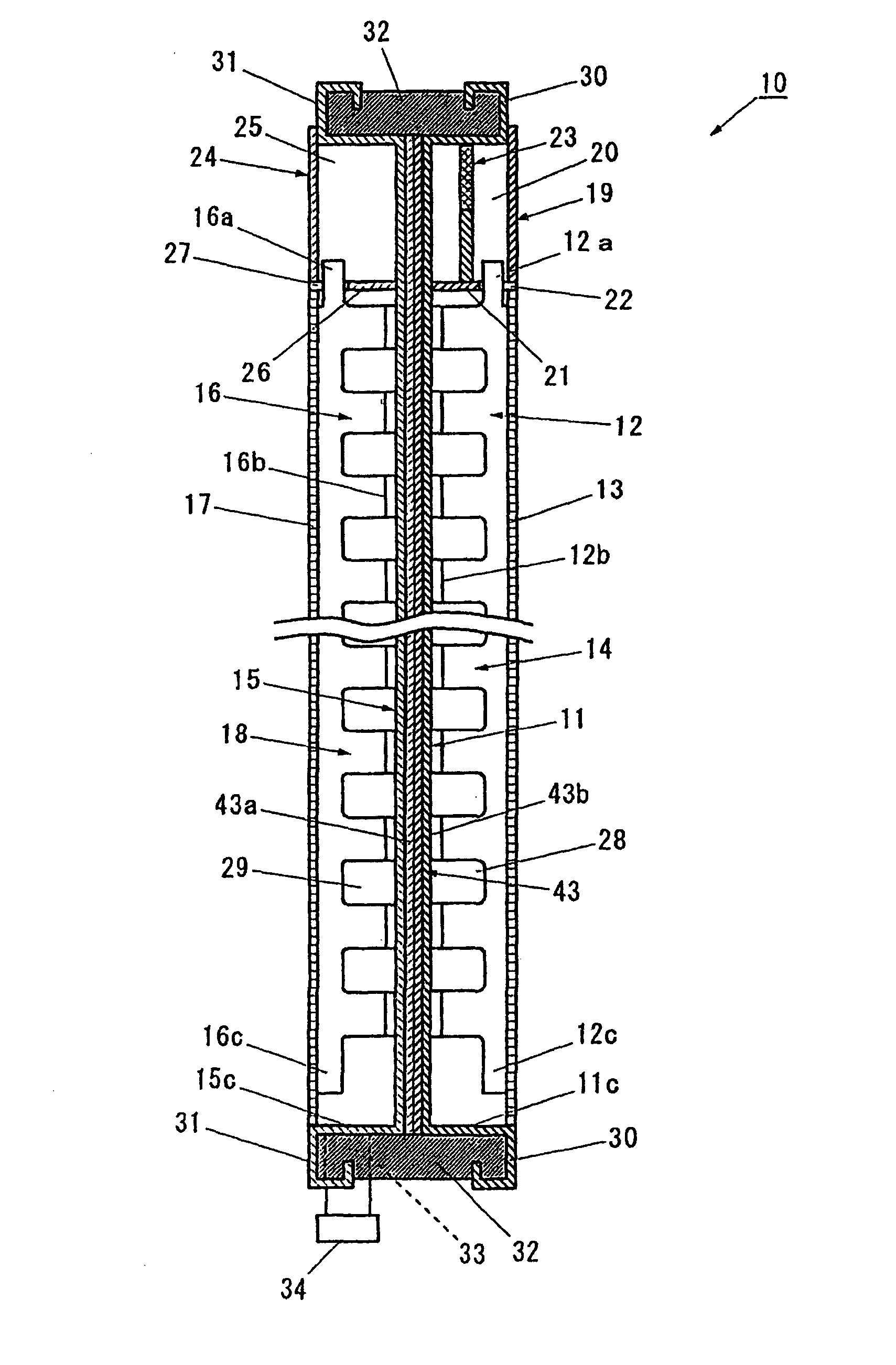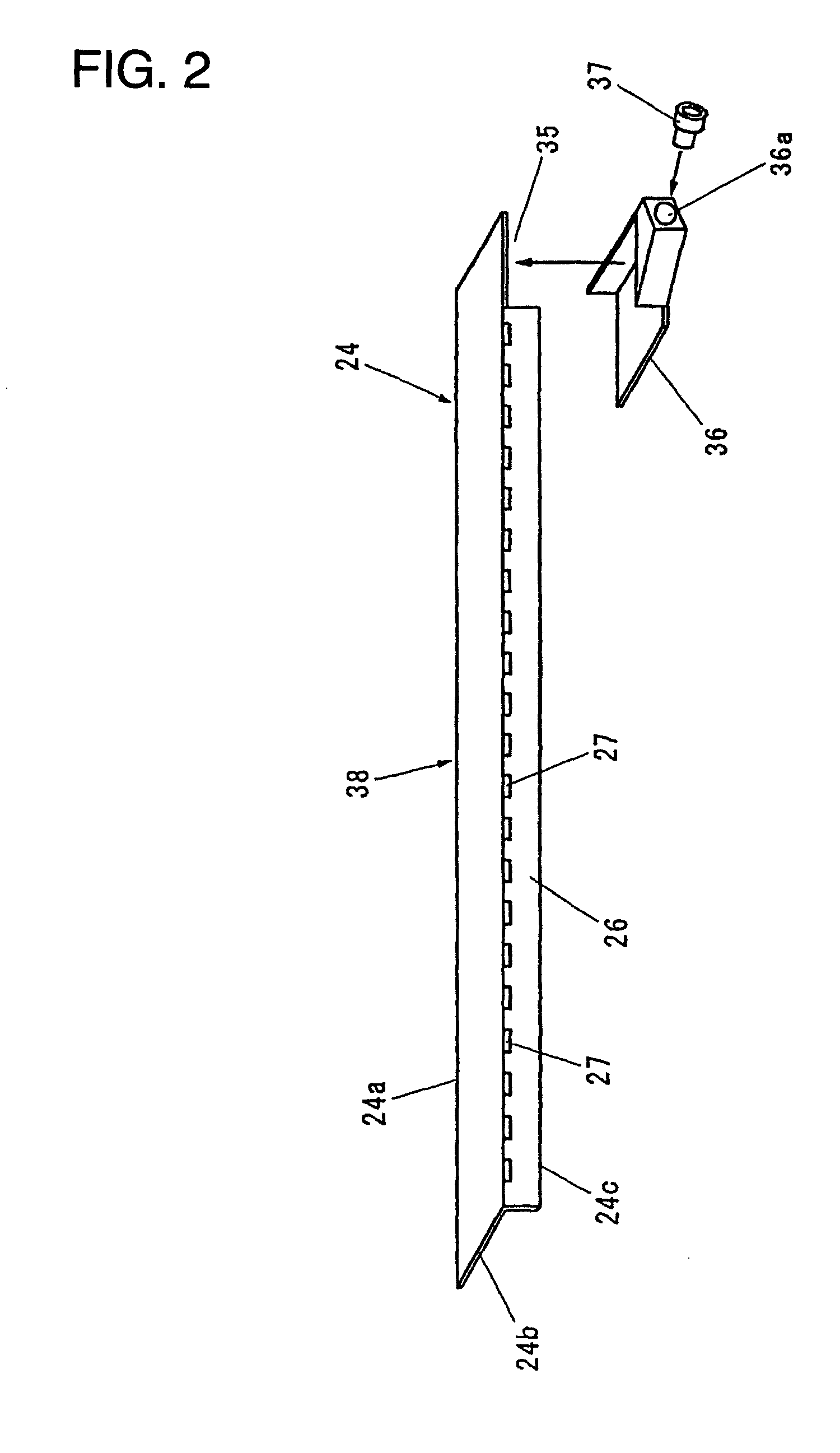Method of manufacturing electrolyzer unit, and method and system for welding electrolyzer unit and electrolyzer unit rib
a manufacturing method and electrolyzer technology, applied in the manufacture of tools, electrolysis components, welding/soldering/cutting articles, etc., can solve the problems of difficult to perform straining and cooling metal measures, and achieve the effect of suppressing the possibility of liquid leakage, reducing the number of welding portions, and prolonging the tim
- Summary
- Abstract
- Description
- Claims
- Application Information
AI Technical Summary
Benefits of technology
Problems solved by technology
Method used
Image
Examples
example 2
[0240] (1) Construction of Cathode Rib
[0241] Material.fwdarw.Nickel
[0242] Thickness.fwdarw.1.5 mm
[0243] Number of projections.fwdarw.One per pan contact portion
[0244] Height of projections.fwdarw.0.8 mm
[0245] Diameter of projections.fwdarw.7.0 mm
[0246] (2) Construction of Cathode Pan
[0247] Material.fwdarw.Nickel
[0248] Thickness.fwdarw.1.0 mm
[0249] (3) Construction of Clad Plate
[0250] Material.fwdarw.Stainless steel layer (SUS316)+titanium layer
[0251] Thickness of stainless steel layer.fwdarw.3.0 mm
[0252] Thickness of titanium layer.fwdarw.0.5 mm
[0253] (4) Construction of Anode Pan
[0254] Material.fwdarw.Titanium
[0255] Thickness.fwdarw.1.0 mm
[0256] (5) Construction of Anode Rib
[0257] Material.fwdarw.Titanium
[0258] Thickness.fwdarw.1.5 mm
[0259] Number of projections.fwdarw.One per pan contact portion
[0260] Height of projections.fwdarw.0.3 mm
[0261] Diameter of projections.fwdarw.7.0 mm
[0262] (6) Welding Condition
[0263] Weld voltage.fwdarw.400 V
[0264] Pressing force.fwdarw.440 kg
[0265] T...
example 3
[0268] (1) Construction of Cathode Rib
[0269] Material.fwdarw.Nickel
[0270] Thickness.fwdarw.1.5 mm
[0271] Number of projections.fwdarw.One per pan contact portion
[0272] Height of projections.fwdarw.0.8 mm
[0273] Diameter of projections.fwdarw.7.0 mm
[0274] (2) Construction of Cathode Pan
[0275] Material.fwdarw.Nickel
[0276] Thickness.fwdarw.1.0 mm
[0277] (3) Construction of Clad Plate
[0278] Material.fwdarw.Iron layer+titanium layer
[0279] Thickness of iron layer.fwdarw.3.3 mm
[0280] Thickness of titanium layer.fwdarw.0.7 mm
[0281] (4) Construction of Anode Pan
[0282] Material.fwdarw.Titanium
[0283] Thickness.fwdarw.1.0 mm
[0284] (5) Construction of Anode Rib
[0285] Material.fwdarw.Titanium
[0286] Thickness.fwdarw.1.5 mm
[0287] Number of projections.fwdarw.One per pan contact portion
[0288] Height of projections.fwdarw.0.3 mm
[0289] Diameter of projections.fwdarw.7.0 mm
[0290] (6) Welding Condition
[0291] Weld voltage.fwdarw.440 V
[0292] Pressing force.fwdarw.440 kg
[0293] Transformation ratio.fwdarw.30:1...
PUM
| Property | Measurement | Unit |
|---|---|---|
| depth | aaaaa | aaaaa |
| width | aaaaa | aaaaa |
| width | aaaaa | aaaaa |
Abstract
Description
Claims
Application Information
 Login to View More
Login to View More - R&D
- Intellectual Property
- Life Sciences
- Materials
- Tech Scout
- Unparalleled Data Quality
- Higher Quality Content
- 60% Fewer Hallucinations
Browse by: Latest US Patents, China's latest patents, Technical Efficacy Thesaurus, Application Domain, Technology Topic, Popular Technical Reports.
© 2025 PatSnap. All rights reserved.Legal|Privacy policy|Modern Slavery Act Transparency Statement|Sitemap|About US| Contact US: help@patsnap.com



